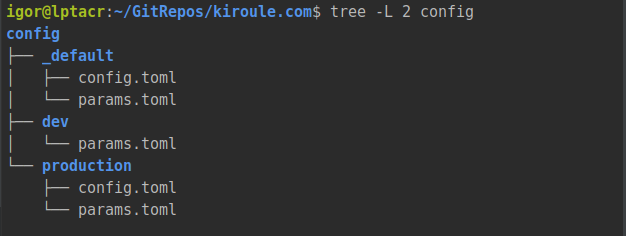Manage Environment-Specific Settings for Hugo-Based Website
In this post, I describe how I migrated the configuration of my site from a single config file with placeholders to the Hugo way of managing environment-specific settings, namely the “Configuration Directory” method. This article is the fifth part of the series “Building Your Blog, the Geeky Way”.
Anyone related to software development or system administration is familiar with the concept of environments. It all starts with the local development(local) environment, usually a developer’s laptop or workstation. That is where most of the coding is done. Then follows the development(dev) environment where you deploy and test results of your work done in the local. Before deploying in the production environment, there are two or three more environments in between, for instance, QA, staging, and/or pre-production.
So when I started developing my website, I applied this concept of environments. In my case, having three environments: local, dev, and production, is more than sufficient when using Hugo, GitHub, and Netlify, although Netlify allows you to have multiple non-production environments.
In Hugo, to manage your site configuration, you use the config.toml, config.yaml, or config.json file, which is found in the site root. You can use the same config file for each of your environments, but it depends on a Hugo theme you chose for your website. For a minimalistic theme, that could work just fine. But if your theme offers integration with external services such as Google Analytics, Disqus, or Algolia, using your non-prod environments for development and testing may affect your production environment. For example, using the same Google Analytics ID in local and dev environments will pollute your usage statistics with data from these non-prod environments.
Since I initially didn’t have much experience with Hugo, I solved the problem of managing environment-specific settings using the placeholder approach, which was inspired by Netlify’s Inject environment variable values. With this approach, you replace in your config.toml file the actual value of configuration setting with a placeholder text, for instance:
googleAnalytics = "GOOGLE_ANALYTICS_ID_PLACEHOLDER"
algolia_indexName = "ALGOLIA_INDEX_NAME_PLACEHOLDER"
To replace these placeholders with actual values that correspond to the environment in question, I created the config.sh script:
sed -i "s/GOOGLE_ANALYTICS_ID_PLACEHOLDER/${GOOGLE_ANALYTICS_ID}/g" config.toml
sed -i "s/ALGOLIA_INDEX_NAME_PLACEHOLDER/${ALGOLIA_INDEX_NAME}/g" config.toml
grep -E 'googleAnalytics|algolia_indexName' config.toml
Provided that the GOOGLE_ANALYTICS_ID and ALGOLIA_INDEX_NAME environment variables are set accordingly either manually in the local environment or via the netlify.toml file for the dev and production environments, the config.sh script should be executed right before the hugo command:
a) in the local environment
$ ./config.sh && hugo server
b) in the dev and production environments
$ ./config.sh && hugo
So far, this approach served me well. But I recently discovered that Hugo has built-in functionality for managing environment-specific settings, that is the Configuration Directory. It is based on a single site config file that used together with additional configuration files for each environment that placed in the config directory in the site root. Since it’s considered as the proper way to manage configuration settings for a Hugo-based website, I switched from my custom approach with placeholders to the Hugo’s Configuration Directory method.
Now let’s look at the implementation details of this migration:
The source code is available here.config/ Directory
Since I have local, dev, and production environments, the config directory contains one directory for each environment where the _default maps to the local environment:
The _default/config.toml file here is the same config file that used to be located in the site root, but without the googleAnalytics and disqusShortname settings and the algolia_indexName parameter. The params.toml file in each environment directory contains only the algolia_indexName parameter set to the corresponding value, for example, like in dev/params.toml:
algolia_indexName = "dev_kiroule"
The production/config.toml contains only the googleAnalytics and disqusShortname settings.
Default Environments
As per the Hugo documentation, this is how default environments are chosen when using the hugo command:
Default environments are development with
hugo serveand production withhugo.
In other words, Hugo implicitly adds --environment development and --environment production to hugo serve(r) and hugo commands accordingly. Thus, when you use the hugo server command in your local environment, Hugo will use the settings from the config/_default directory. And when the hugo command is used, Hugo will merge all settings from the config/production directory on top of the settings from the config/_default.
netlify.toml
The following changes have been made to the netlify.toml file:
- The
GOOGLE_ANALYTICS_IDvariable was removed from[context.production.environment]section. - Execution of the
config.shscript was removed from thecommandsetting in[context.dev]and[context.production]sections. --environment devoption was added to thehugocommand in thecommandsetting in[context.dev]section to merge all the settings from theconfig/devdirectory on top of the settings from theconfig/_default.
I had to keep the ALGOLIA_INDEX_NAME variable for each environment context since it’s needed to execute the algolia/run-data-upload.sh script.
This is how the netlify.toml file looks like after the above changes:
[build]
publish = "public"
command = "hugo"
# URL: https://kiroule.com/
[context.production.environment]
HUGO_VERSION = "0.72.0"
HUGO_ENV = "production"
HUGO_ENABLEGITINFO = "true"
# Algolia index name is needed to execute algolia/run-data-upload.sh
ALGOLIA_INDEX_NAME = "prod_kiroule"
[context.production]
command = "hugo --buildFuture && algolia/run-data-upload.sh -p"
# URL: https://dev--kiroule.netlify.app/
[context.dev.environment]
HUGO_VERSION = "0.72.0"
# Algolia index name is needed to execute algolia/run-data-upload.sh
ALGOLIA_INDEX_NAME = "dev_kiroule"
[context.dev]
command = "hugo --environment dev -b $DEPLOY_PRIME_URL --buildFuture --buildDrafts && algolia/run-data-upload.sh -p"
The source code for the placeholder approach is available here.
Continue reading the series “Building Your Blog, the Geeky Way”:
- Start Blogging With Hugo, GitHub and Netlify
- Configure Custom Domain and HTTPS on Netlify
- Add Favicon to Hugo-Based Website
- Automate Data Upload to Algolia Index
- Manage Environment-Specific Settings for Hugo-Based Website
- Automate Data Upload to Algolia Index : Revisited
- Configure Custom Domain and HTTPS in Netlify : Revisited
- Use Aliases to Redirect Old URLs
- Automate Data Upload to Algolia Index with GitHub Actions
